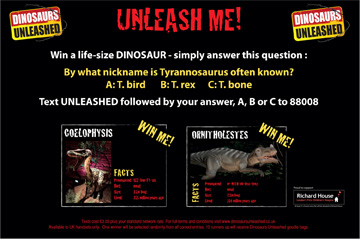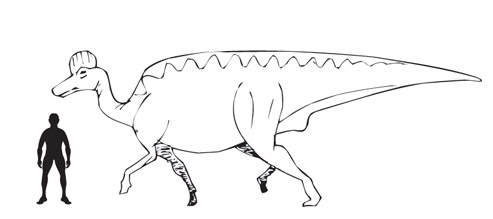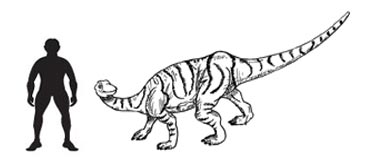New Permanent Dinosaur Display to Open on July 16th
Staff at the Natural History Museum of Los Angeles County (California) are busy with the final preparations for the grand opening of their new permanent dinosaur exhibition. The new “Dino Halls”, part of a multi-million dollar refurbishment and development programme at the Museum are being opened on Saturday 16th July.
The all-new, 14,000-square-foot Dinosaur Hall, marks the halfway point of the Museum’s seven-year transformation. Twice the size of the Museum’s old dinosaur galleries, the new permanent exhibition will feature over 300 fossils and 20 complete mounts of dinosaurs and sea creatures.
The hall will rival the world’s leading dinosaur halls for the number of individual fossils displayed, the size and spectacular character of the major mounts, including the world’s only Tyrannosaurus rex growth series, (tyrannosaurs depicted in a family group, that will get Professor Phil Currie and his colleagues very excited no doubt), and the accessible integration of recent scientific discoveries and research into the displays.
We at Everything Dinosaur, have followed the progress of the building work with great interest, to read an earlier article on the refurbishment of the museum: New Ways to Display Your Dinosaurs – Museums for the 21st Century.
In the new, spacious, light-filled galleries, visitors come face-to-face, and in some cases can walk underneath, huge prehistoric skeletons, as well as see the dinosaurs as they were in life, illustrated on giant murals and animated in hands-on interactive and multi-media displays. It is great to hear about such innovative ways in which museum specimens can be shown to the public, we recall the excitement we all felt when we walked into the American Museum of Natural History (New York) for the first time and saw their spectacular mount of the Barosaurus mother and baby fending off an attack from two Allosaurus – simply astonishing.
In addition to views on this grand scale, visitors can also get a very detailed, close-up look at fossils at this Los Angeles County based museum, they can touch several, look at many through magnifying glasses as a scientist would, and in the interactive displays, excavate from simulated dirt and rock as palaeontologists would.
Throughout the exhibition, visitors will encounter science not as static information, but as a vibrant, ongoing investigation into dinosaur mysteries, some resolved, and some still being explored. They will learn that the investigations are still taking place today, reinforcing the fact that discovery is not just something that happened in the past; it is work that is happening now, all around us.
Natural History Museum
In the press release we were kindly sent, an image is incorrectly labelled as a Corythosaurus, we don’t think this is so and we have asked the Dinosaur Institute to clarify (we will keep you posted on this).
Dr Jane Pisano, the Museum’s President and Director commented:
“The new Dinosaur Hall is an exciting realisation of the goal of our institution-wide transformation, which is to bring the Museum’s research and collections vividly to life for a public that is hungry for the real thing, an encounter with authentic fossils and with the genuine, fascinating process of scientific exploration. This exhibition will emerge as one of the great dinosaur experiences in the world, and a major reason why NHM (Natural History Museum of Los Angeles County) is one of America’s leading natural history museums.”
Remarkable Specimen
To provide insight into how scientists puzzle out answers to questions about dinosaurs, to reveal the stories behind these astonishing specimens, the exhibition draws from the ambitious discovery and research programmes of the NHM’s in-house Dinosaur Institute (DI), directed by world-renowned palaeontologist and exhibition lead curator, Dr Luis Chiappe. The DI’s field research programme has located key specimens all over the world, from the dinosaur-rich “Badlands” of the American West to remote parts of South America and Asia.
The centrepiece of the exhibition is the T. rex growth series, containing an extraordinary fossil trio of the youngest known baby, a rare juvenile, and a recently-discovered young adult, one of the ten most complete T. rex specimens in the world.
The Dinosaur Hall’s other standout exhibits include an imposing new Triceratops; the armour-backed Stegosaurus; the predator Allosaurus; a 68-foot, long-necked Mamenchisaurus; and giant marine reptiles that swam in the oceans covering what is today California. Two-thirds of the full fossil skeletons have never been displayed before. Specimens that were previously seen have all been re-articulated into more dynamic new poses based on recent scientific findings.
Dr Chiappe, outlining his aspirations for the new “Dino Halls” stated:
“We hope to inspire new generations of scientists, since this exhibition highlights the experience of going outdoors and finding treasures, and then understanding how they fit within the current scientific record. Most dinosaur exhibitions are organised around specific types of dinosaurs or by periods of time. Our approach is to use new discoveries and research findings to bring visitors into the world of dinosaurs, exploring the great questions of how they lived, behaved, and died, and whether they still exist.”
A Remarkable Experience
For those people not lucky enough to visit this museum over the opening weekend, here is a quick guide to the extensive exhibits on display at these newly refurbished galleries as provided by the Natural History Museum of Los Angeles County to staff members at Everything Dinosaur.
The Dinosaur Hall extends through two conjoining two-story galleries. One is a part of the recently restored 1913 Building (the Beaux-Arts structure that was the Museum’s original home). The second belongs to the newer 1920s building, which has been seismically renovated and outfitted with floor-to-ceiling windows that give passers by in Exposition Park a peek at the giants inside.
One of the exhibit goals was to bring visitors closer than ever to the real specimens,85 percent of the exhibition’s fossils are the real thing, not casts or reconstructions, and remove barriers whenever possible. To accomplish this, the major fossil skeletons were placed on special platforms that allow the fossils to be shown without glass barriers, and to pass directly underneath a dinosaur neck and stand under a T. rex skull.
This is a key to the exhibition’s visitor experience, as many of these fossils were prepared and articulated in recent years, using modern methods that forgo the thick layers of shellac used by palaeontological conservators of decades past. Never-before-seen details of the fossils are revealed. Some specimens have rich red and green hues, coloured by the minerals in the lands where they were found. Some contain visible traces of skin textures, respiratory systems, and in one instance, the stomach contents of a last meal.
The Dinosaur Hall is organised around a series of questions: What is a dinosaur? What was their world like? How did they live, grow and behave? And finally, what happened to them? Such a layout is indeed innovative and will permit the curators to continually update the exhibits in the light of new scientific research.
A quick walk through the exhibit reveals these main ideas, as they appear on large, colourful mural illustrations. For visitors who crave more background, context, and stories of discovery, multi-layered content is available for readers in text and in touchscreen kiosks, and for young non-readers, in simple mechanical, manual games.
Upstairs on the mezzanine are displays about the lab and field aspects of palaeontology. These are hands-on experiences, with touchable specimens, magnifying glasses, and a look at the tools and tricks of dinosaur research, from a camping supply list for a fossil hunting expedition, to Dr Chiappe’s hand-written field journals.
Gallery One
As visitors enter the exhibition’s first gallery, they are immediately greeted by a magnificent, never-before displayed Triceratops, mounted on a contoured platform with details of the new research that has re-interpreted, via the animal’s forelimb, how this huge creature walked in life. Forelimbs of Triceratops in the fossil record are extremely rare, we think that this was one of the “choicest cuts” and as they were eminently portable, at least to an adult Tyrannosaurus rex most carcases lost their forelimbs so they had little chance of being preserved in the fossil record.
Images show the fantastic views visitors can get of the museum specimens. The state-of-the-art supporting armature, permits this Triceratops to be posed in such a way that visitors can look right into the fossilised skeleton, revealing details not seen by members of the public before – terrific!
Framing the gallery is a 40-foot “fossil wall” showcasing 100 diverse dinosaur specimens, an artful take on traditional palaeontological display, with bones, teeth, eggs, footprints, skin patches, and coprolites (fossilised droppings). Two touch-screen kiosks work as virtual indexes here, allowing visitors to explore what each bone is, and in some cases, turning them around 360 degrees on the screen.
The exhibition’s largest specimen, a 68-foot Mamenchisaurus, stands in front of the gallery’s large central windows with its long neck and tail sprawling throughout the gallery. This is one of the exhibit’s few casts, most other mounts include real fossils. We suspect that posing such an impressive beast using the real fossils would have been a health and safety nightmare – so for once a replica fossil specimen is used.
Suspended from the ceiling overhead, and also viewable from the gallery’s new mezzanine, are marine reptiles that lived in the warm sea that once covered California. Here, visitors will come face to face with the exhibit’s marine monsters.
The mosasaur Plotosaurus and the plesiosaur Morenosaurus are both cantilevered over the main floor in a breath-taking, gravity-defying scene. In some cases, large fossil plaques show animals still encased in dirt and rock, a display method that offers staggering glimpses of prehistory. There is a mosasaur plaque, for instance, that reveals traces of a partial body outline, skin colour markings, external scales, a down-turned tail, branching bronchial tubes, and evidence of the animal’s last meal 85 million years ago – fish.
At the end of Gallery One, visitors will get an insight into the field experiences and work done by the Dinosaur Institute expedition teams, led by Chiappe. On five television screens, video from a recent field expeditions in Utah shows the often gruelling conditions and exciting moments of discovery that characterise Dinosaur Institute excursions. Nearby, a specimen is displayed, in the plaster “jacket” with which it was transported out of the quarry it was found in.
Gallery Two – Tyrannosaur Growth Series
The show-stopping centrepiece in this gallery is the platform featuring a very special trio: the young adult Tyrannosaurus rex nicknamed Thomas after the discoverer’s brother (34 feet, and approximately 17 years old) joined by a 20-foot juvenile (approximately 14 years old) and an 11-foot baby (2 years old). The growth series is a fascinating look at the ways that T. rex specimens grew, a process that included incredible growth spurts and body changes. After hatching as a 2-foot, 6-pound baby, for example, a T. rex could reach 30 to 35 feet (10,000 to 12,000 pounds) in less than two decades – if it was lucky.
But the growth series is also a snapshot of dinosaur life; the terrain on which they are mounted finds Thomas and the baby standing on one side, while the juvenile lurches toward the carcass of a duck-billed Edmontosaurus. Though nearby content is careful to point out that theories about a long-extinct animal’s behaviour are just that, the scene intends to raise questions about the behaviour of the T. rex. A nod perhaps towards Professor Phil Currie and his fellow researchers at the University of Alberta and the IVPP (Beijing) who have recently re-inflated the debate about pack behaviour in large theropods.
In another panel, the mystery of how and when the large dinosaurs died out is introduced, with evidence for a mass extinction event at the end of the Mesozoic. This section also highlights the evolutionary connection between dinosaurs and birds, providing compelling evidence about why the latter should be considered living dinosaurs.
The second level of the exhibition takes a closer look at the science behind these specimens, from how we know where to look for specimens to the work we do in palaeontology labs. One area focuses on field work and the surprising data that a quarry can reveal in addition to its fossil treasures and examples of excavation methods (which, unlike lab work, have not changed drastically over the last several decades). Multi-media interactive kiosks allows visitors to “excavate” specimens and investigate the finds. The companion area focuses on laboratory discoveries, research tools that have evolved to include high-tech microscopes, CT scans, and genome studies.
This is a project five years in the making with hundreds of contributors. Inside NHM, the Dinosaur Hall was supervised by Dr Karen Wise, VP of Education and Exhibits. Dr Chiappe was its lead curator; Jennifer Morgan was its project manager.
The exhibition was designed by Brooklyn-based Evidence Design, with graphics from Los Angeles’ Kim Baer Design Associates (KBDA). Lexington was the fabricator, and New York-based United Field created its multi-media assets. Two of North America’s finest fossil mount makers worked on the exhibition. Phil Fraley Productions, the company that headed the articulation of Sue, the iconic T. rex of Chicago’s Field Museum of Natural History; undertook the T. rex specimens, the giant marine reptiles, and the Triceratops. The Ontario, Canada-based Research Casting International remounted the exhibition’s largest specimen, the 68-foot Mamenchisaurus and six additional medium-sized mounts.
The seismic retrofit and historic renovation of the Dinosaur Hall galleries was led by CO Architects Principal, Jorge de la Cal, and Cordell Corporation President, Don Webb, with Matt Construction. We at Everything Dinosaur would like to congratulate all those people who have been involved in the project and one day, perhaps, some of our team members will get the chance to visit such an exciting museum – if only our busy schedules (and our budget) will allow.
For models ane replicas of Tyrannosaurus rex and other dinosaurs (no need to worry about a budget): Natural History Museum Dinosaur Models.







